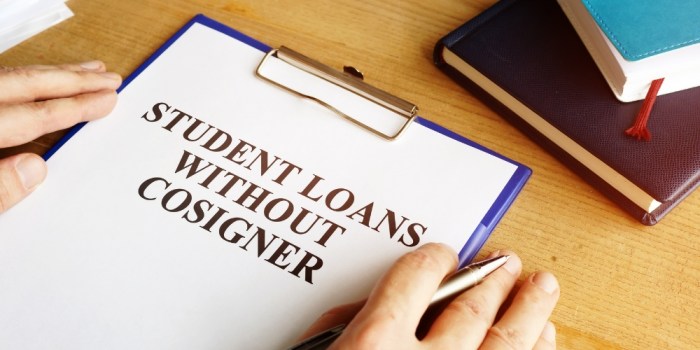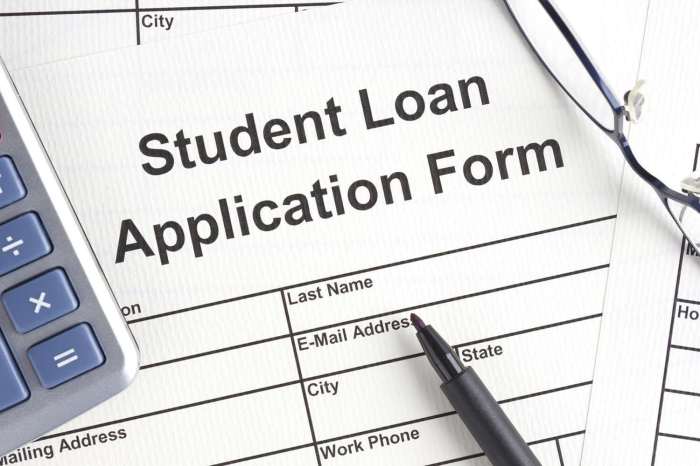
Navigating the world of student loans can feel overwhelming, especially when considering the cosigner requirement. Many students wonder: Is securing a student loan without a cosigner even possible? The answer, thankfully, is often yes, but it hinges on several key factors. This guide explores the eligibility criteria, available loan types, the application process, and influential factors that determine your chances of securing a loan without needing a cosigner to back you.
Understanding these elements empowers students to make informed decisions about financing their education and paves the way for a smoother loan application experience. We’ll delve into both federal and private loan options, highlighting the pros and cons of each, and offering strategies to improve your chances of approval. Ultimately, this guide aims to demystify the process and provide you with the knowledge you need to confidently pursue your educational goals.
Types of Student Loans Available Without a Cosigner

Securing a student loan without a cosigner can be challenging, but it’s achievable for students who demonstrate strong financial responsibility and creditworthiness. Several types of federal and private loans are available, each with its own set of eligibility requirements, interest rates, and repayment terms. Understanding these differences is crucial for making an informed borrowing decision.
Federal Student Loans Without a Cosigner
Federal student loans are generally considered more favorable than private loans, especially for those without a cosigner. This is because they often offer lower interest rates, more flexible repayment options, and robust borrower protections. The primary types of federal student loans available without a cosigner are unsubsidized Stafford Loans and Direct PLUS Loans (for graduate students and parents).
Unsubsidized Stafford Loans
Unsubsidized Stafford Loans are available to undergraduate and graduate students based on financial need. Interest accrues on these loans from the time they are disbursed, even while the student is still in school. Interest rates are set annually by the federal government and are generally lower than private loan rates. Repayment typically begins six months after graduation or when the student drops below half-time enrollment. The loan amount is determined by the student’s cost of attendance minus any other financial aid received.
- Key Features: Lower interest rates than private loans, flexible repayment plans, deferment and forbearance options available, government-backed, no credit check required.
Direct PLUS Loans
Direct PLUS Loans are available to graduate students and parents of dependent undergraduate students. Credit checks are conducted, and borrowers with adverse credit history may be required to obtain a cosigner or meet specific eligibility requirements. However, it’s possible to qualify without a cosigner if the credit check is satisfactory. Interest rates are generally higher than unsubsidized Stafford Loans but still often lower than private loan rates. Repayment begins shortly after the loan is fully disbursed.
- Key Features: Available to graduate students and parents, higher interest rates than Stafford Loans, credit check required, repayment begins soon after disbursement.
Private Student Loans Without a Cosigner
Private student loans are offered by banks, credit unions, and other financial institutions. Securing a private loan without a cosigner requires a strong credit history and a high credit score. Interest rates are typically variable and are based on the borrower’s creditworthiness. Repayment terms vary depending on the lender, but generally, repayment begins shortly after graduation or when the student drops below half-time enrollment.
- Key Features: Higher interest rates than federal loans, variable interest rates common, credit check required, repayment terms vary by lender, may require a cosigner if credit is poor.
Comparison of Federal and Private Loans Without a Cosigner
Federal loans generally offer better terms and more borrower protections than private loans. Federal loans often have lower interest rates, more flexible repayment options, and income-driven repayment plans. Private loans, while potentially accessible without a cosigner for those with excellent credit, often come with higher interest rates and less favorable repayment terms.
Calculating Total Loan Cost
The total cost of a student loan is calculated by adding the principal amount borrowed to the total interest accrued over the repayment period. The formula is:
Total Cost = Principal + (Principal x Interest Rate x Number of Years)
For example, a $10,000 loan with a 5% annual interest rate over 10 years would cost:
Total Cost = $10,000 + ($10,000 x 0.05 x 10) = $15,000
This calculation is simplified and doesn’t account for compounding interest or variations in repayment schedules. Accurate calculations require using a loan amortization calculator, readily available online. This allows for more precise estimations, incorporating factors like monthly payments and interest capitalization.
The Application Process for Student Loans Without a Cosigner

Securing a student loan without a cosigner can be more challenging but is achievable. The process typically involves a more rigorous evaluation of your creditworthiness and financial history. Understanding the steps involved and preparing the necessary documentation will significantly increase your chances of approval.
The application process for student loans without a cosigner generally follows a structured path, requiring careful attention to detail and timely submission of all required materials. Failure to provide complete and accurate information can lead to delays or rejection of your application.
Required Documents and Information
Applicants should gather all necessary documentation before beginning the application process. This significantly streamlines the application procedure and reduces the risk of delays. Missing information is a common cause of application processing delays.
- Proof of Identity: This typically includes a government-issued photo ID, such as a driver’s license or passport.
- Social Security Number (SSN): Your SSN is crucial for verifying your identity and tracking your loan application.
- Tax Information: Tax returns (or tax transcripts) from the past few years will demonstrate your income and financial history.
- Bank Statements: Recent bank statements showing your account activity and available funds provide insight into your financial stability.
- Proof of Enrollment: An acceptance letter or enrollment verification from your chosen educational institution is essential.
- Credit Report: Lenders will likely pull your credit report to assess your creditworthiness. A good credit score is highly advantageous.
Completing the Free Application for Federal Student Aid (FAFSA)
The FAFSA is the primary application for federal student aid, including grants, loans, and work-study programs. Completing this form accurately and thoroughly is the first crucial step in the financial aid process. The information provided on the FAFSA will determine your eligibility for federal student aid.
- Gather Information: Before starting, collect your Social Security number, federal tax returns, and W-2s (if applicable), as well as your parents’ financial information (if you are a dependent student).
- Create an FSA ID: You and your parent(s) will need an FSA ID to access and sign the FAFSA.
- Complete the Application: Carefully fill out all sections of the FAFSA online. Double-check all information for accuracy.
- Submit the Application: Once completed, submit your FAFSA electronically. You will receive a Student Aid Report (SAR) confirming receipt of your application.
The Verification Process
After submitting your FAFSA, you may be selected for verification. This process involves providing additional documentation to confirm the information you provided on the FAFSA. Verification ensures the accuracy of the information used to determine your financial aid eligibility.
- Verification Request: If selected, you will receive a notification requesting additional documentation.
- Gather Documents: Gather the requested documents, such as tax returns or W-2s, and submit them to your school’s financial aid office.
- Processing Time: The verification process can take several weeks, so it is important to respond promptly.
- Updated SAR: Once verification is complete, you will receive an updated SAR reflecting the changes.
Factors Affecting Loan Approval and Interest Rates
Securing a student loan without a cosigner hinges on several key factors that lenders carefully assess to determine your eligibility and the interest rate you’ll receive. Understanding these factors can significantly improve your chances of approval and potentially save you money on interest payments over the life of the loan.
Credit History’s Influence on Loan Approval and Interest Rates
A strong credit history is a significant determinant of loan approval and the interest rate offered. Lenders view a positive credit history, characterized by on-time payments and low credit utilization, as an indicator of your responsible financial behavior. Individuals with excellent credit scores typically qualify for lower interest rates, reflecting the lender’s reduced risk. Conversely, a poor credit history, marked by missed payments or high debt, can lead to loan denial or significantly higher interest rates, as lenders perceive a greater risk of default. For example, a borrower with a credit score above 750 might secure a loan with an interest rate of 5%, while a borrower with a score below 600 might face an interest rate exceeding 10%, or even loan denial.
Income and Employment History’s Impact on Loan Terms
Your income and employment history are crucial factors in assessing your ability to repay the loan. Lenders prefer applicants with a stable income and a consistent employment history, demonstrating a capacity to make regular loan payments. A steady income stream, whether from employment or other reliable sources, reassures lenders of your ability to manage debt responsibly. Conversely, inconsistent income or a history of job changes may raise concerns about your repayment capacity, potentially leading to higher interest rates or loan denial. For instance, a borrower with a stable, high-income job for five years will likely receive more favorable loan terms compared to a borrower with a history of frequent job changes and fluctuating income.
Other Factors Considered by Lenders
Beyond credit history and income, lenders consider several other factors, including your debt-to-income ratio (DTI) and assets. Your DTI reflects the proportion of your monthly income dedicated to debt repayment. A high DTI indicates a greater financial burden, potentially increasing the risk of default. Conversely, a lower DTI suggests a greater capacity to manage additional debt. Assets, such as savings accounts or investments, can also influence loan approval and interest rates. These assets provide lenders with additional assurance of your ability to repay the loan, potentially leading to more favorable terms.
Comparison of Interest Rates Across Lenders
Interest rates for student loans without cosigners can vary significantly among lenders. Different lenders have different risk assessments and lending policies, resulting in a range of interest rates for similar loan amounts. For example, one lender might offer a 6% interest rate, while another might offer 7% or even higher, depending on the borrower’s profile and the prevailing market conditions. It’s crucial to compare offers from multiple lenders before accepting a loan to secure the most favorable terms.
Credit Score and Interest Rate Relationship
Imagine a graph with the horizontal axis representing credit score (ranging from 300 to 850) and the vertical axis representing the interest rate (as a percentage). The graph would show a generally inverse relationship. As the credit score increases, the interest rate decreases, depicted by a downward-sloping curve. The curve would be steeper at lower credit scores, indicating a more significant impact of credit score on interest rates in that range. At higher credit scores, the curve would flatten, indicating a smaller change in interest rate for each incremental increase in credit score. This visualization illustrates how a higher credit score translates to significantly lower interest rates, especially for borrowers with lower credit scores.
Summary

Securing a student loan without a cosigner is achievable for many students, but it requires careful planning and a thorough understanding of the eligibility requirements and application process. By diligently building a strong credit history, demonstrating financial independence, and exploring various loan options, students can significantly increase their chances of successfully obtaining the financial support they need for their education. Remember to compare lenders and loan terms carefully to find the most suitable option for your individual circumstances.
Question & Answer Hub
What is a cosigner, and why is it sometimes required for student loans?
A cosigner is an individual who agrees to repay your student loan if you fail to do so. Lenders often require cosigners for students with limited or no credit history because the cosigner’s creditworthiness mitigates the lender’s risk.
How can I improve my chances of getting a student loan without a cosigner?
Build a strong credit history, demonstrate financial independence (through employment and income), maintain a good academic record, and carefully complete the loan application.
What happens if my loan application is denied?
If your application is denied, understand the reasons provided by the lender. You can reapply after addressing any issues or explore alternative financing options such as scholarships, grants, or part-time jobs.
Are there any penalties for defaulting on a student loan?
Yes, defaulting on a student loan can have serious consequences, including damage to your credit score, wage garnishment, and difficulty obtaining future loans.
